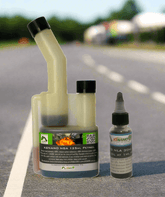Resources and Results
What is XSNANO, and how does it work?
XSNANO Reduces Emissions
Why XSNANO is the best fuel additive.
Compared with other similar products, XSNANO is the latest generation of liquid Nano-additives with the most advanced physical properties in the world and is the only high-efficiency, ultra-concentrated, multi-functional, energy-saving and environmental protection additive in the world.
It is the world’s leading "multi-in-one" high-efficiency energy-saving and environmental protection additive which is equivalent of an integrated multifunctional additive of booster, oil-saving agent, environmental protection agent, machine maintenance agent and fuel cleaner.
It is the only additive in the world that has obtained the most technical appraisal and comprehensive test report. It is the only physical additive certified by EPA of the United States (EPA certification number: 216920001), ENAC of Europe and EPA of Russia.
XSNANO can reduce emissions
Emission tests show up to 98% emission reduction in most internal combustion engines when using XSNANO fuel additives.
XSNANO can burn off Carbon and other NOx gases in the combustion chamber.
Which is the cause of most DPF, EGR and other blockages
Nano-technology is making FUEL and OIL more efficient
Introducing XSNANO - Your Solution for Enhanced Fuel and Oil Performance! At Lubrication Solutions P/L, we're excited to introduce you to our cutting-edge Nano-Technology Fuel and Oil additives designed to revolutionise your fuel efficiency and lubrication needs. Our mission is to provide you with a cleaner, more efficient, and environmentally conscious solution, all while maximising your vehicle's potential.
Our flagship product, XSNANO fuel additive, is the culmination of advanced liquid-phase nanotechnology and radiation chemical engineering. As leaders in the industry, we've harnessed these technologies to create the world's most advanced and efficient clean fuel additive. Backed by rigorous international scientific research and a talented team, we're committed to merging innovation with practicality to benefit both business and society.
Discover the advantages of XSNANO Fuel additives (NDA and NGA), which can be seamlessly incorporated into your fuel at a ratio of 1 part per 10,000 units
XSNANO In Fuel (NDA and NGA)
Achieve up to 28% Improved Fuel Economy
Make a Positive Impact with Emission Reductions of up to 98%
Boost Octane Ratings by 4-8 RON, Eliminating the Need for High Octane Fuel
Keep Your Engine Clean with Effective Carbon Deposit Inhibition
Cleaner Fuel System, Lower Maintenance Costs, and Extended Engine Life
pWorks Wonderfully Across All Engines, Fuels, Climates, and Conditions
XSNANO in OIL (NLA)
And that's not all! Introducing XSNANO NRL, our exceptional lubrication additive that elevates your oil's performance. When combined with our fuel additive, XSNANO NRL achieves remarkable results at a ratio of 1 part per 1,000 units for all oil types (engine, gearbox, auto transmissions, differentials, hydraulics).
- Reduce Friction and Wear, Prolonging Engine Lifespan
- Withstand High Pressure and Temperatures for Optimal Protection
- Enhance Power by Up to 28% through Improved Compression
- Increase Fuel Efficiency by 2% - 8%
- Contribute to Reduced Pollution
- Enjoy a Quieter Engine with Noise Reductions of up to 18 decibels
- Choosing a selection results in a full page refresh.























